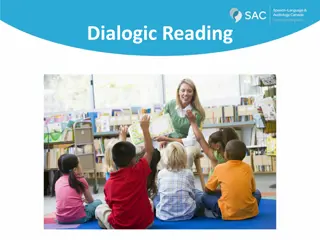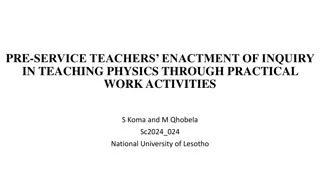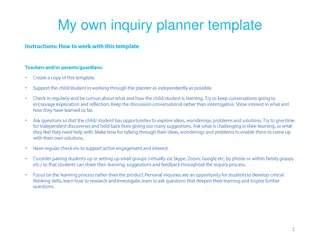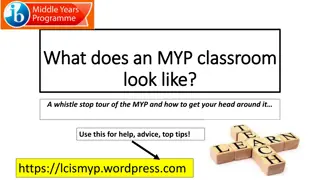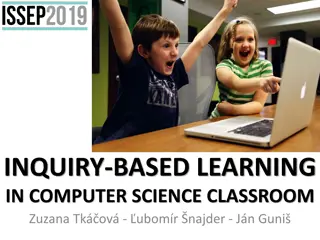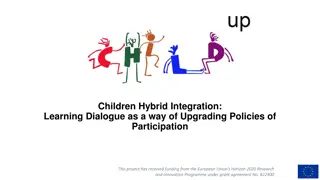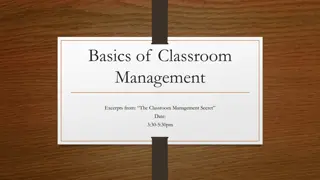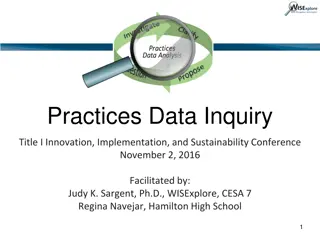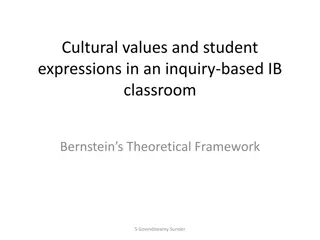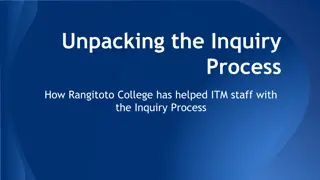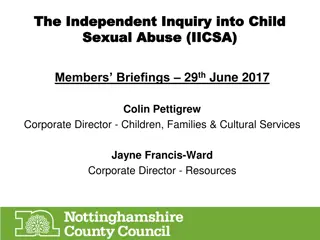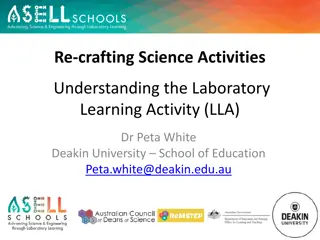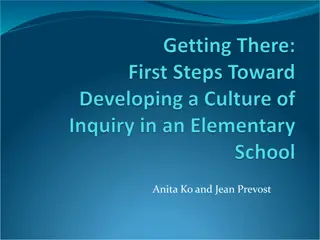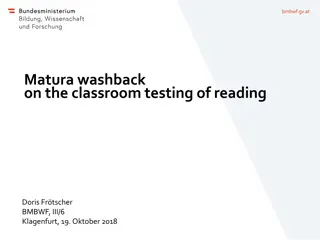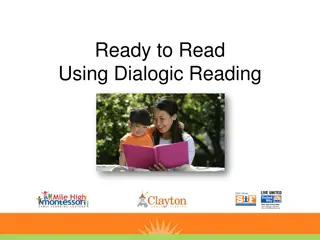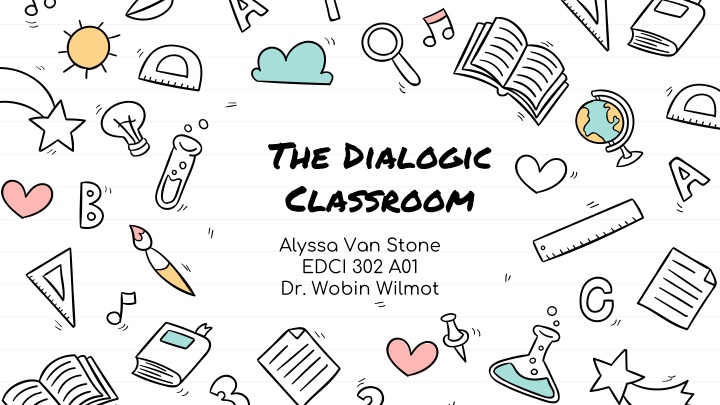
Preparing Students and Teachers for a Successful Dialogic Classroom
Learn how to ensure students and teachers are ready for a successful dialogic classroom environment through scaffolding, preparation, setting expectations, and modeling positive behaviors. Discover the importance of creating a safe and collaborative space where everyone can share ideas and form new understandings. Find out about research emphasizing the significance of teacher and student readiness in fostering a dialogic classroom.
Download Presentation

Please find below an Image/Link to download the presentation.
The content on the website is provided AS IS for your information and personal use only. It may not be sold, licensed, or shared on other websites without obtaining consent from the author. If you encounter any issues during the download, it is possible that the publisher has removed the file from their server.
You are allowed to download the files provided on this website for personal or commercial use, subject to the condition that they are used lawfully. All files are the property of their respective owners.
The content on the website is provided AS IS for your information and personal use only. It may not be sold, licensed, or shared on other websites without obtaining consent from the author.
E N D
Presentation Transcript
The Dialogic Classroom Alyssa Van Stone EDCI 302 A01 Dr. Wobin Wilmot
How do you ensure students and teachers are prepared for a successful dialogic classroom?
Important points 01 02 03 04 Bringing it all together Teacher Scaffolding and Preparation The Student Scaffolding and Preparation Environment
What is the Dialogic Classroom? The dialogic classroom is an environment every student should feel safe in to share ideas, question, challenge, and form new understandings within. The dialogic classroom is a open learning environment where students are collaborating and sharing their perspectives to create different connections and form bridges to their own meanings of a topic.
My Research: In my research I found that students and teachers must be prepared before attempting a dialogic classroom environment. This is important to ensure students are feeling confident, safe, and have all the tools to be able to participate. In my research, this was teachers who were participating in the study. They studied video recordings of lessons before performing it in their own classrooms to ensure understanding.
Importance of Scaffolding Environment Tools Expectations Preparation Modelling Not only do the teachers need to scaffold themselves before the lesson, they must make sure they are using scaffolding language throughout the entire lesson to promote more connections. (for example asking open ended questions) Teachers must go over what is expected within a dialogic classroom such as being positive and respectful to all students and their ideas. Sets the tone of the environment. Teachers must display what a dialogic classroom is supposed to look,sound, and feel like. Making sure students have tools to help them participate is very important. ( for example a question sheet) Offering behaviour for imitation including demonstrations of particular skills.
Teacher Scaffolding Preparation In one of my references, I found a research study done on teachers that watch recordings of successful dialogic classroom lessons. This study ultimately scaffolded the teachers into recreating and attempting a successful dialogic classroom. The study showed that teachers who studied it before hand were more successful.
Student Scaffolding Perspective Questioning Challenging Another important highlight of my research was the importance of children having different perspectives. When they have different perspectives, the dialogic classroom allows them to accept and understand others and create a deeper meaning of knowledge through their peers. Students who are participating in the dialogic classroom often use questioning. This may be open ended questions from the teacher, or questioning other students perspectives to understand more deeply. Students who are participating in the dialogic classroom may also choose to disagree with another student. Ensuring the students are doing this kindly can spark dialogue in groups and create deeper learning outcomes.
Bringing it all together Teachers and students must be prepared before so dialogic talk can be successful. Teachers must know how to successfully scaffold their students into questioning, listening, participating, and challenging in a respectful manner. This is done with modelling this, debriefing and setting expectations before jumping in. When dialogic talk is successful, my research has shown how much of an impact it makes on participation and learning in the classroom. I found multiple articles researching on when students participate in the group setting, they often learn more than students who do not participate.
Curricular Big IDeas, Competencies, and Content for grade 4 Big Ideas: Exploring stories and other texts helps us understand ourselves and make connections to others and to the world, and texts can be understood from different perspectives. These reflect the dialogic classroom as in a dialogic atmosphere, students are making connections to others and the world, from different perspectives within the classroom. 01 Core Competencies: Use a variety of comprehension strategies before, during, and after reading, listening, or viewing to deepen understanding of text. Consider different purposes, audiences, and perspectives in exploring texts. To exchange and to build shared understanding and to use oral storytelling processes. These competencies tie together with dialogic talk as dialogic talk is a comprehension strategy, and it is done to deepen understanding of text and perspectives. Dialogic talk is ultimately exchanging and building understanding from each other. 02 , Content: oral language strategies: focusing on the speaker, asking questions to clarify; listening for specifics, expressing opinions, speaking with expression, staying on topic, taking turns, and metacognitive strategies: talking and thinking about learning (e.g., through reflecting, questioning, goal setting, self-evaluating) and to develop awareness of self as a reader and as a writer. This is reflected in dialogic talk as students ask questions, listen, take turns, think about others perspectives, and question in order to participate successfully. 03
Significance to my teaching This is significant to my teaching as I learnt a lot from this inquiry project. I learnt specifically how to make sure the classroom is prepared, so it can be successful and meaningful. My teaching beliefs have always appreciated collaboration within children. Within my findings I found an article talking about the dialogic gap. This is how students benefit from talking to other students who use relatively the same vocabulary and maturity level. I read that this is why dialogic teaching is so successful. Students collaborating and the teachers scaffolding students to talk to each other at their particular age level and how that is beneficial to learning was something I never knew. I now understand dialogic teaching and the dialogic classroom thoroughly, and cannot wait to experience it in the classroom.
Thanks for Listening Any questions? ?
References Alexander, R. (2018) Developing dialogic teaching: genesis, process, trial. Research Papers in Education, 33:5, 561-598, DOI: 10.1080/02671522.2018.1481140 BC s New Curriculum. (n.d.). Retrieved October 10, 2020, from https://curriculum.gov.bc.ca/curriculum/english-language-arts/core/introduction Hardman, J. (2020). Developing the repertoire of teacher and student talk in whole-class primary English teaching: Lessons from England. Australian Journal of Language & Literacy, 43(1), 68 82. Thwaite, A. (2019). Halliday s View of Child Language Learning: Has it been Misinterpreted? Australian Journal of Teacher Education, 44(5). Vrikki, M., Wheatley, L., Howe, C., Hennessy, S., & Mercer, N. (2018;2019;). Dialogic practices in primary school classrooms. Language and Education, 33(1), 85-100. doi:10.1080/09500782.2018.1509988 Wegerif, R. (2011). Towards a dialogic theory of how children learn to think. Thinking Skills and Creativity, 6(3), 179-190. doi:10.1016/j.tsc.2011.08.002 Wilmot, Robin. (2020, September 17) Halliday s Systematic Functional Linguistics [Lecture Notes]. Brightspace.

